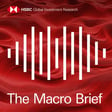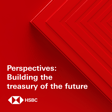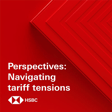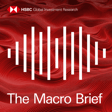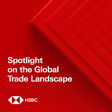Become a Creator today!Start creating today - Share your story with the world!
Start for free
00:00:00
00:00:01

Bonds and the Fed, cooling commodities and transatlantic inflation - HSBC Global Research
Steven Major explains the importance of the upcoming FOMC meeting for bond yields, Paul Bloxham considers what’s next for commodity prices and Chris Hare looks at what’s driving inflation on both sides of the Atlantic. Disclaimer.
To stay connected and to access free to view reports and videos from HSBC Global Research click here.
Hosted on Acast. See acast.com/privacy for more information.
Transcript
Introduction to HSBC Global Viewpoint Podcast
00:00:00
Speaker
This is HSBC Global Viewpoint, your window into the thinking, trends and issues shaping global banking and markets.
00:00:09
Speaker
Join us as we hear from industry leaders and HSBC experts on the latest insights and opportunities for your business.
00:00:17
Speaker
Thank you for listening.
Federal Reserve Meeting Preview: Impact on Markets
00:00:22
Speaker
You're listening to the HSBC Global Research Macro Viewpoint, our weekly review of the key reports from our team of economists and strategists across the globe.
00:00:33
Speaker
Coming up this week, the Federal Reserve will be holding a September policy meeting next week.
00:00:38
Speaker
We find out why the outcome could be crucial for global bond yields.
00:00:41
Speaker
We consider what's next for global commodities following a huge run-up in prices.
00:00:47
Speaker
And we look at what's driving inflation on both sides of the Atlantic.
00:00:50
Speaker
This podcast was recorded on Thursday, the 16th of September, 2021.
00:00:54
Speaker
Our full disclosures and disclaimers can be found in the link attached to the podcast.
US Treasury Yields: Stability and Future Outlook
00:01:01
Speaker
Hello, I'm Chris Brown-Hulmes.
00:01:03
Speaker
And I'm P.S.
00:01:03
Speaker
Butler.
00:01:04
Speaker
All eyes will be on the Federal Reserve next week as they hold their September meeting.
00:01:08
Speaker
And with new guidance due on the path of policy rates, there could be big implications for the bond markets.
00:01:14
Speaker
Let's get the details from Stephen Major, Global Head of Fixed Income Research.
00:01:18
Speaker
Steve, you've noted that 10-year U.S. Treasury yields are smack bang in the middle of their range for the year.
00:01:23
Speaker
What does that tell you about the way investors are viewing the market?
00:01:26
Speaker
I thought it was quite worth reflecting on the fact that we have probably seen the high for the year.
00:01:32
Speaker
Back in March, we had 1.74% and people were calling for 2% and above.
00:01:38
Speaker
So we have moved on a fair bit.
00:01:41
Speaker
And I think that maybe gradually people are accepting the idea that yields can't go up very much.
00:01:48
Speaker
For us, it's a validation of the lower for longer view and that when and if rates ever do go up, they won't go up very far.
00:01:57
Speaker
There's obviously a lot of focus in the market about when the Fed tapers.
00:02:01
Speaker
For you, that's much less important than the Fed's future path of policy rates.
00:02:05
Speaker
Why are you emphasizing that so much?
00:02:07
Speaker
Well, we've done a lot of work on that over the years, Chris, and there's no causal link between asset purchases and asset prices.
00:02:18
Speaker
The point of it is that treasuries and in fact government bonds generally around the world are mainly priced off of the path of the policy rate, the short rate.
00:02:29
Speaker
Now there may be some coincidence around tapering and other things that are going on but I really don't think there's a robust link.
00:02:38
Speaker
So for us what would really matter is any indication on the 2024 path of rates via the dot plot.
00:02:46
Speaker
And we are expecting to hear something about the Fed's projection for future rates, the so-called dot plot, as you've just mentioned, at next week's meeting, aren't we?
00:02:54
Speaker
Yeah, I don't think we want to be in the business of forecasting what other people are forecasting, because that's ultimately what it is, right?
00:03:01
Speaker
It's a median of 17 other forecasts.
00:03:04
Speaker
But the point is, we did have a hawkish surprise back in June when the 2023 median dot went up 50 basis points.
00:03:14
Speaker
the outcome was lower yields and a flatter curve.
00:03:17
Speaker
Now that doesn't have to be repeated, but to me that is something to look out for.
00:03:22
Speaker
I think somehow this 2024 dot is going to be between the 2023 and longer run, and if there's going to be an outcome it should be fairly benign for rates and if anything flatten the curve.
00:03:39
Speaker
But it's fair to say that you're not expecting a repeat of the taper tantrum that we saw back in 2013.
00:03:45
Speaker
Well, that's the point, Chris.
00:03:46
Speaker
You can see looking at the way the markets behaved, valuations and communications are completely different.
00:03:54
Speaker
So the Fed has been very good with communication.
00:03:57
Speaker
They've been very clear.
00:03:58
Speaker
And the valuations in terms of bonds are not as stretched.
00:04:01
Speaker
The yields aren't so far away from the longer run equilibrium.
00:04:05
Speaker
Also, look at real yields.
00:04:07
Speaker
They've been very well behaved.
00:04:09
Speaker
compared to 2013.
00:04:10
Speaker
So all of the evidence is there to say we haven't had a taper tantrum and we're not going to have one.
00:04:17
Speaker
Steve, that's a great summary.
00:04:18
Speaker
Thanks very much.
00:04:20
Speaker
Thank you, Chris.
Global Commodity Prices Post-COVID: Analyzing Trends
00:04:23
Speaker
Global commodity prices have been on a tear since the onset of the COVID-19 pandemic.
00:04:29
Speaker
So could the upswing become a super cycle?
00:04:31
Speaker
Let's get the thoughts of Paul Bloxham, our chief economist for Australia, New Zealand and global commodities.
00:04:37
Speaker
He joins us from Sydney.
00:04:39
Speaker
Paul, welcome to the podcast.
00:04:40
Speaker
Great to be here.
00:04:41
Speaker
So, Paul, has that price momentum continued more recently?
00:04:45
Speaker
Well, we saw a very large rise in commodity prices just after the COVID shock, as you said.
00:04:51
Speaker
But we have seen actually signs that that is losing momentum in recent months.
00:04:55
Speaker
Certainly the earliest ramp up was much, much more rapid.
00:04:59
Speaker
And we've seen a range of commodity prices have started to level out.
00:05:03
Speaker
Things like oil prices are tracking at similar rates now to where they were a couple of months ago.
00:05:08
Speaker
Copper prices seem to be past their peak.
00:05:10
Speaker
Iron ore prices have come down a long way.
00:05:13
Speaker
And if you look at the agricultural space, although agricultural prices are quite high, they too have levelled out.
00:05:19
Speaker
Now, there are some that have risen, things like coal and gas, but if you sum together the overall global economy,
00:05:25
Speaker
commodity price index, it is losing momentum.
00:05:29
Speaker
And what has been driving that cooling in momentum?
00:05:32
Speaker
Well, it's a collection of factors, but a part of it is on the demand side and related to the slowdown we're seeing in global growth.
00:05:39
Speaker
This is partly related to the Delta outbreak, and that's having an impact.
00:05:44
Speaker
But it's also related to the fact that China has seen a slowdown in its infrastructure and
00:05:48
Speaker
and its property investment, these are two quite metals-intensive activities.
00:05:52
Speaker
We've also seen the Chinese authorities take quite direct measures to try to contain some metals markets.
00:05:59
Speaker
So all of that has sort of combined to slow down the upswing in metals.
00:06:04
Speaker
On the oil front, a lot of the story is that OPEC Plus has been delivering more supply back to the market, and that's been keeping the oil price from shooting a lot higher as that supply side adjusts.
00:06:15
Speaker
and on agricultural commodities.
00:06:17
Speaker
Chinese demand has softened a bit.
00:06:19
Speaker
The weather's looked a little bit better.
00:06:20
Speaker
This is combined to see those agricultural commodity prices broadly level out.
00:06:26
Speaker
Prices may be cooling, but they're up almost 100% from the lows of 2020.
00:06:31
Speaker
Do you still maintain this won't be a super cycle?
00:06:33
Speaker
Well, if we look at where commodity prices are, as you say, they've risen by about 100% since the trough in early 2020.
00:06:41
Speaker
But if we keep in mind and we compare that to the early 2000s,
00:06:45
Speaker
Back between 2002 and 2008, global commodity prices rose by 320%.
00:06:50
Speaker
So we're still on an order of magnitude smaller than that.
00:06:54
Speaker
And we wouldn't describe what's happened so far as a super cycle.
00:06:58
Speaker
And as the listeners may be aware, we've had a view for a while now that we don't think that this ramp up is going to turn out to be a super cycle anymore.
00:07:09
Speaker
A big part of that narrative for us is China is just at a very different stage of development now to what it was in the early 2000s.
00:07:17
Speaker
They don't need to build as much infrastructure or as much housing.
00:07:20
Speaker
Debt levels are a lot higher now than they were back then.
00:07:23
Speaker
And we still see China as the dominant source of demand for the range of commodities and particularly for the metals.
00:07:29
Speaker
So we don't subscribe to the view that we're likely to see a global commodity prices super cycle this time around.
00:07:35
Speaker
What do you see as the key risks to commodity prices right now?
Commodity Market Risks: Supply Side Factors
00:07:39
Speaker
So most of the risks we see if we look forward are on the supply side rather than demand.
00:07:44
Speaker
We think demand is going to soften, global GDP is going to slow down a bit.
00:07:48
Speaker
But there are a range of supply side risks out there.
00:07:51
Speaker
One is the perennial risk of the weather, of course, and that has a direct impact on agricultural commodities.
00:07:57
Speaker
The weather has contributed in recent times.
00:07:59
Speaker
We had a La Nina phenomenon and there's a risk that we run into a second season of La Nina and that constrains supply.
00:08:05
Speaker
Things like the COVID-19 shock itself, the pandemic, has disrupted supply in very specific commodities, things like lumber and coffee.
00:08:13
Speaker
It's hard to predict those, but we may very well see more idiosyncratic shocks in individual commodities related to the pandemic.
00:08:20
Speaker
Geopolitics plays a role as well, and that's been playing a role in the aluminium market just recently.
00:08:25
Speaker
And then shipping costs are also up.
00:08:27
Speaker
The big one, though, that we really focus on in the report we published is rapidly changing climate change policy
00:08:34
Speaker
and what that means for the energy sector, but also what it means for the metals.
00:08:39
Speaker
And with the uncertainty that climate policy is bringing to energy markets and fossil fuels, what's your outlook
Climate Change and Energy Markets: Future Scenarios
00:08:45
Speaker
for oil?
00:08:45
Speaker
Well, certainly the climate change policy story is very much an effect on the energy market and particularly fossil fuels as you describe.
00:08:52
Speaker
At the moment, actually, when you look at what we're seeing in coal and gas
00:08:56
Speaker
Those are two commodities where prices have really spiked recently.
00:08:59
Speaker
It just reminds us how dependent the world is still on these fossil fuels and how supply disruptions, which are causing those price rises, can have a pretty decent impact.
00:09:09
Speaker
On the oil front, Gordon Gray spends a fair bit of time talking about this in the report we published about the longer term story.
00:09:16
Speaker
I mean, there's a really neat chart in there that shows that, you know, if you look forward to 2050, if business as usual means that oil demand actually doesn't look too different to now, but if countries do commit and take action to get back to net zero, you know, the estimates show a 75% fall in oil demand by 2050.
00:09:34
Speaker
So those are two vastly different worlds.
00:09:37
Speaker
in terms of thinking about oil demand, the investment environment, and again, just an illustration of how uncertain things are over that longer-term horizon.
00:09:45
Speaker
Paul, thank you very much.
00:09:47
Speaker
Thank you.
Inflation Trends: Regional Variations and Drivers
00:09:50
Speaker
Figures published in the US and UK this week showed it's far too soon to relax about inflation.
00:09:55
Speaker
In fact, the UK saw its biggest monthly increase in prices since records began in 1997.
00:10:00
Speaker
Chris Hare, European economist, has been looking at the factors driving divergences in inflation prospects across the US, UK and Eurozone.
00:10:08
Speaker
He joins me now.
00:10:09
Speaker
Chris, let's start with those US and UK August inflation numbers.
00:10:13
Speaker
What did they tell us?
00:10:14
Speaker
Yes, some pretty interesting inflation numbers on both sides of the Atlantic.
00:10:17
Speaker
Now, the US numbers were broadly in line with expectations, but we're still seeing elevated rates of headline consumer price inflation up above the 5% mark in the US.
00:10:27
Speaker
So pretty high numbers there.
00:10:28
Speaker
If anything, though, the UK data were more interesting in August.
00:10:32
Speaker
We saw that really big increase in headline CPI from 2% to 3.2%.
00:10:39
Speaker
That's a huge increase.
00:10:40
Speaker
Now, a lot of that relates to base effects that we already knew about relating to things like VAT or a sort of echo effect from the eat out to help out restaurant discount scheme that took place last year.
00:10:53
Speaker
But actually, over and above those base effects, the headline inflation rate was materially stronger than we had expected.
00:11:00
Speaker
So that's one reason we thought it was worth revising up our UK inflation outlook.
00:11:04
Speaker
And not only that, you know, in Europe, we're seeing these really big increases in wholesale gas and electricity prices.
00:11:11
Speaker
And we thought that it was worth upgrading our UK outlook off the back of that as well.
00:11:15
Speaker
So we think that given all these effects, which we think are set to be transitory, you know, UK inflation could be well above the 2% mark through this year and indeed into next year, too.
00:11:26
Speaker
Now, I know you've been looking at inflation prospects across the US Eurozone and UK.
00:11:31
Speaker
What are the common factors there?
00:11:33
Speaker
So there's a lot of common factors that have pushed inflation rates up across all these economies over the past few months, when we're thinking about higher energy prices, for example.
00:11:44
Speaker
But there are some differences as well.
00:11:47
Speaker
So in the US where we're seeing the highest inflation rates, a lot of that is to do with used car price inflation, which really took off earlier on this year.
00:11:56
Speaker
But in terms of other things that we're seeing, probably we're seeing some impact of global supply chain disruption.
00:12:03
Speaker
In the US and the UK in particular, we think we're seeing what I call reopening effects where demand is coming back for newly reopened sectors and leading to some price pressures there.
00:12:14
Speaker
And a more fundamental issue that might be emerging is in labour markets.
00:12:18
Speaker
And again, this is in particular in the US and the UK, where it looks like we're seeing some pretty significant labour shortages.
00:12:25
Speaker
And that could be starting to have upward pressure on wage related inflation too.
Monetary Policy Divergence: Rate Hikes vs. Easing
00:12:30
Speaker
In general, inflation is a bit more subdued in the Eurozone.
00:12:32
Speaker
Is there a reason for that?
00:12:33
Speaker
Yes, I think the labor market really is at the crux of that, at least for the time being, it doesn't look like those labor shortages I mentioned in the UK and the US are as acute in the Eurozone.
00:12:45
Speaker
And actually looking forward, we think kind of fundamental inflation pressures from the labor market in the Eurozone are set to be softer.
00:12:53
Speaker
One thing that we observe on the European continent is that we see a lot of wage indexation practices.
00:12:58
Speaker
That means that wages tend, we think, to be less responsive to labour shortages.
00:13:03
Speaker
It's also worth pointing out that in the eurozone, inflation expectations are somewhat lower too.
00:13:10
Speaker
So when we're thinking about the outlook, we think that a lot of this near term inflation strength is set to be transitory.
00:13:16
Speaker
In the US and the UK, inflation should eventually settle towards the 2% mark.
00:13:21
Speaker
But because of that,
00:13:22
Speaker
difference in Eurozone labour markets, we actually see headline inflation in the Eurozone settling back towards more like one and a half percent.
00:13:30
Speaker
And final question then, Chris, what is what does this all mean for monetary policy from central banks?
00:13:35
Speaker
Well, in terms of central banks, we see a story of divergence.
00:13:40
Speaker
Now, in the UK, for example, we see two rate rises taking place next year, bringing bank rate up to half a percent by the end of next year.
00:13:49
Speaker
In the US, we expect interest rate increases to start in 2023.
00:13:54
Speaker
But the Eurozone story is very different.
00:13:56
Speaker
We're seeing in our forecast continued net asset purchases under its QE programs.
00:14:03
Speaker
And we see interest rates staying very much at their floor for the foreseeable future.
00:14:08
Speaker
And really at the core of that is that fundamental difference in the underlying inflation outlook.
00:14:14
Speaker
Chris, thanks so much for explaining all that to us.
00:14:16
Speaker
Thank you.
Conclusion and Listener Engagement
00:14:19
Speaker
So that's it for today's programme.
00:14:21
Speaker
Thank you to our guests, Steve Major, Paul Bloxham and Chris Hare.
00:14:25
Speaker
From all of us on the team, thanks for listening.
00:14:27
Speaker
Please join us again next week for another edition of the Macro Viewpoint.
00:14:34
Speaker
Thank you for listening today.
00:14:36
Speaker
This has been HSBC Global Viewpoint Banking and Markets.
00:14:40
Speaker
For more information about anything you heard in this podcast or to learn about HSBC's global services and offerings, please visit gbm.hsbc.com.
